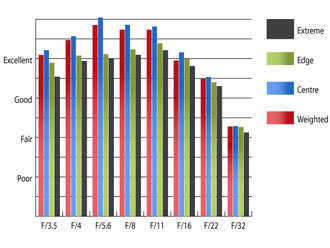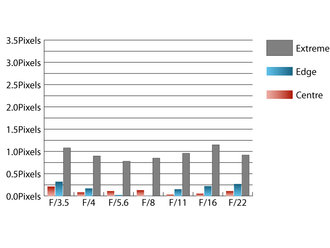Samyang T-S 24mm f/3.5 ED AS UMC Lens Review
Samyang T-S 24mm f/3.5 ED AS UMC Performance
Samyang are rapidly gaining a good reputation for the optical performance of their manual focus lenses, and this lens should help to build on that. Sharpness in the centre of the frame is already excellent at maximum aperture, with clarity towards the edge of the 35mm frame area with the lens centred not being too far behind. With the lens still centred, stopping down to between f/4 and f/11 results in outstanding sharpness in the centre of the frame, with the clarity towards the edges of the frame exceeding excellent levels in the same aperture range.With the lens fully shifted, sharpness is very good furthest from the optical centre, reaching excellent levels of clarity between f/5.6 and f/11.
 Resolution at 24mm | How to read our chartsThe blue column represents readings from the centre of the picture frame at the various apertures and the green is from the edges. Averaging them out gives the red weighted column.The scale on the left side is an indication of actual image resolution. The taller the column, the better the lens performance. Simple. For this review, the lens was tested on a Nikon D700 using Imatest. |
Within the confines of the 35mm frame area whilst the lens is centred, chromatic aberrations barely register, and shouldn't be an issue. With the lens fully shifted, fringing just exceeds one pixel width at f/3.5 and f/16, dropping to more acceptable levels at f/5.6.
 Chromatic aberration at 24mm | How to read our chartsChromatic aberration is the lens' inability to focus on the sensor or film all colours of visible light at the same point. Severe chromatic aberration gives a noticeable fringing or a halo effect around sharp edges within the picture. It can be cured in software.Apochromatic lenses have special lens elements (aspheric, extra-low dispersion etc) to minimize the problem, hence they usually cost more. For this review, the lens was tested on a Nikon D700 using Imatest. |
Due to the nature of the lens, it isn't possible to accurately measure the falloff across the whole image circle with Imatest. Across the normal 35mm frame with the lens centred, the corners of the image are 1.26 stops darker than the image centre at Maximum aperture and uniform illumination is achieved with the lens stopped down to f/8 or beyond. As is the case with other tilt-shift optics, applying a severe tilt will darken the image in the viewfinder.
As is typical with wide angle lenses, some barrel distortion is present. Imatest detected 2.53% barrel distortion, which is only a mild amount, although you'd be forgiven for expecting less from a lens like this.
Contrast is good, even when shooting into the light, although the lens isn't quite as contrasty as manufacturer's own lenses. Strong light sources might cause issues with flare though, so it pays to take care when shooting in those conditions.

Panoramic images are easy to produce by shifting the lens, taking advantage of the optic's larger image circle| 1/1250 sec | f/5.6 | 24.0 mm | ISO 200
Add your message
Login required
Please login here or if you've not registered, you can register here. Registering is safe, quick and free.
Please login here or if you've not registered, you can register here. Registering is safe, quick and free.
photodo Stats
1102 lenses
428 MTF tests
74 in-depth photodo reviews
100+ users join each day
Help the lens community by reviewing or rating a lens today via our lens search
428 MTF tests
74 in-depth photodo reviews
100+ users join each day
Help the lens community by reviewing or rating a lens today via our lens search
Latest Lens Reviews
- Chinon 28mm f/2.8 Vintage Lens Review
- Canon EF 70-200mm f/4L IS II USM Lens Review
- Samyang AF 85mm f/1.4 EF Review
- Sigma 70mm f/2.8 DG Macro Art Review
- Samyang AF 24mm f/2.8 FE Review
- Meike 50mm f/1.7 Review
- Tamron 70-210mm f/4 Di VC USD Review
- Lensbaby Burnside 35mm f/2.8 Review
- Asahi Super Takumar 50mm f/1.4 Review
- Asahi Super-Multi-Coated Takumar 135mm f/3.5 Review
